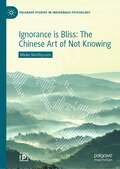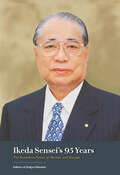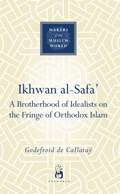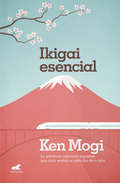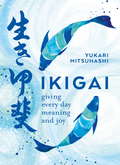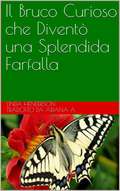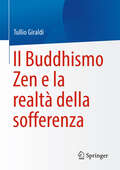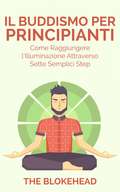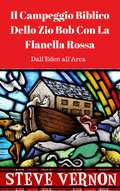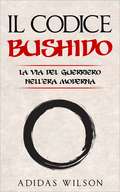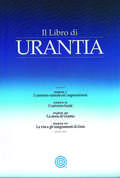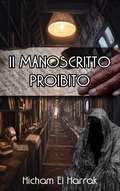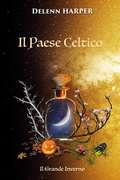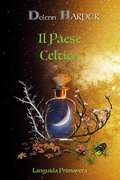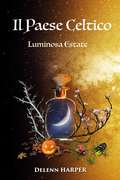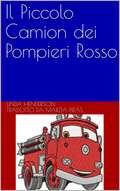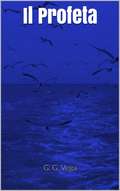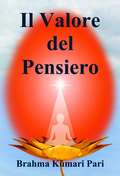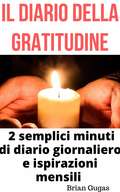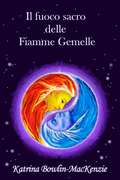- Table View
- List View
Ignorance is Bliss: The Chinese Art of Not Knowing (Palgrave Studies in Indigenous Psychology)
by Mieke MatthyssenThis book examines the popular, yet puzzling, Chinese saying Nande hutu 难得糊涂 to uncover how the ancient Chinese wisdom of not knowing is constructed, interpreted, practiced and valued in contemporary society.Originating in the calligraphy of Qing-dynasty scholar Zheng Banqiao, Nande hutu translates literally as: “hard to attain muddle-headedness”. Mieke Matthyssen traces the historical development of this saying and related philosophies to reveal a culturally conditioned, multi-layered inclination to different forms of not knowing. In contemporary society, she argues, this inclination forms part of a living art: in some respects, a passive, evasive strategy for self-preservation; in other respects, a strategy for coping with intrapersonal, interpersonal and social complexities. Drawing on an extensive range of primary sources and original research, the analysis skillfully combines philosophical and socio-historical analysis with theory from Chinese philosophy, philosophical psychology and the relatively new field of indigenous psychology, to provide an in-depth understanding of how Nande hutu has shaped, and continues to shape, the Chinese psyche and behaviour. This book will appeal to all readers looking for fresh insights into Chinese culture, and in particular to students and scholars of Chinese and Asian studies, cultural and social anthropology, and philosophical and indigenous psychology.
Ikeda Sensei's 95 Years: The Boundless Power of Mentor and Disciple
by Daisaku IkedaBy taking on Josei Toda' s vision as his own, Daisaku Ikeda Sensei tapped into his limitless potential. In Ikeda Sensei' s 95 Years, you' ll learn of his contributions to creating a harmonious world, fostering friendship among nations, spreading Nichiren Buddhism around the globe, and encouraging young people to stand up to fulll their unique missions. But even more important, you' ll be inspired to discover your own power to make a difference.
Ikhwan al-Safa': A Brotherhood of Idealists on the Fringe of Orthodox Islam (Makers of the Muslim World)
by Godefroid De CallatayAn illuminating study of the mysterious Brethren of Purity', the 10th century letter writers whose epistles, although often deemed heretical, exerted a profound influence on the development of Shi'i Islam.
Ikigai esencial: La sabiduría milenaria japonesa que dará sentido a cada día de tu vida
by Ken MogiLa sabiduría milenaria japonesa que dará sentido a cada día de tu vida. «Estar inmerso en el momento presente y obtener placer de ello, prestando atención al mismo tiempo al más mínimo detalle es la esencia del arte de la ceremonia del té. Es extraordinario que Sen no Rikyu, el creador de esta ceremonia en el siglo XVI, llegara a esta conclusión en la era Sengoku, cuando los señores de la guerra, los samuráis, libraban entre sí interminables batallas y seguramente era una época muy estresante.» Occidente siente una fascinación permanente por el modo de vida japonés, y ello supone acceder a la filosofía, la cultura y el patrimonio de ese extraordinario país. Ikigai es un término japonés para referirse a los placeres y el sentido de la vida. Todo el mundo, de acuerdo con la cultura japonesa, tiene ikigai, y este se encuentra mediante la búsqueda, profunda y concentrada, en uno mismo. Es la «razón para levantarse cada mañana», para encontrar el placer, la satisfacción personal en las actividades cotidianas, sea en el trabajo o en el ocio. Una de las razones de la longevidad del pueblo japonés, junto con su alimentación, la práctica de ejercicio moderado y su espiritualidad. Ikigai esencial combina percepciones de los saberes científicos de Ken Mogi sobre el funcionamiento del cerebro, lo cual confiere al libro una perspectiva cognitiva fascinante.
Ikigai: Giving every day meaning and joy
by Yukari MitsuhashiIkigai is a traditional Japanese concept that embodies happiness in living. It is, essentially, the reason that you get up in the morning. This book is about finding your ikigai - identifying your purpose or passion and using this knowledge to achieve greater happiness in your life. Your ikigai doesn't have to be some grand ambition or highly noble life's purpose - it can be something simple and humble, like tending your garden or walking your dog.Having grown up in Japan, Yukari Mitsuhashi understands first hand what ikigai means to Japanese people. Now living in Los Angeles, she has written this book to introduce the traditional concept to a new audience. This is not a 'one size fits all' book. Instead, Ikigai encourages you to look at the details of your life and appreciate the everyday moments as you learn to identify your own personal ikigai. The book includes case studies from a range of people sharing their ikigai, from athletes to writers and business people.With its refreshingly simple philosophy and liberating concepts, this beautifully presented book will be a guide you will return to again and again.
Ikshavakuche Vanshaj: इक्ष्वाकुचे वंशज
by Amishराम राज्य. सर्वार्थानं संपूर्ण भूमी. अर्थातच याची किंमत मोजावी लागते. त्याने ती किंमत मोजली. भारत, इ. पू. ३४०० फुटीरतेमुळे अयोध्या कमजोर झाली होती. त्या भयंकर लढाईमुळे प्रचंड नुकसान झालं होतं. या नुकसानाचे परिणाम समाजात कोलवर झिरपले होते. लंकेचा राक्षस राजा रावण हारलेल्या राज्यावर आपलं शासन लागू करत नाही, त्याऐवजी तो त्यांच्यावर आपला व्यापार लादतो. हारलेल्या साम्राज्यातून पैसा खेचून नेतो. सप्तसिंधू साम्राज्याची प्रजा गरीबी, हताशा आणि भ्रष्टाचारात लोटली जाते. या दलदलीतून बाहेर काढण्यासाठी त्यांना एका समर्थ नेत्याची गरज असते. असा नेता आपल्यातच आहे याची त्यांना कल्पनाही नसते. आपण त्याला ओळखतो हे त्यांना ठाऊक नसतं. प्रचंड यातनांना तोंड देत असलेला, बहिष्कृत राजपुत्र. एक असा राजपुत्र ज्याचं मनोबल खच्ची करण्याचा सगळ्यांनी प्रयत्न केलेला असतो. तो राम नावाचा राजपुत्र. देशवासियांनी त्याला जरी यातना दिल्या तरी त्याचं आपल्या देशावर खूप प्रेम असतं. तो कायद्याचा पाठीराखा बनतो. त्याचे तीन भाऊ, त्याची पत्नी सीता आणि तो स्वतः त्या कोलाहलमिश्रीत अंधःकाराविरोधात ठामपणे उभे राहतात. इथरांनी ठेवलेल्या ठपक्यातून राम बाहेर निघू शकतो का? सीतेवरील त्याचं प्रेम त्याला प्राप्त संघर्षांतून तारून नेतं का? त्याचं बालपण उद्ध्वस्त करणाऱ्या राक्षसांच्या राजा रावणाचा बीमोड तो करतो का? विष्णूपदाला तो प्राप्त होतो का?
Il Bruco Curioso che Diventò una Splendida Farfalla
by Linda HendersonQuesta storia insegna ai bambini e alle bambine la verità sulla meravigliosa trasformazione che avviene quando un bruco diventa una farfalla. Il testo spiega l’evoluzione passo per passo, a un livello che possa risultare comprensibile ai più piccini e alle più piccine. Se volete spiegare ai vostri figli come nascono le farfalle, questo pratico libricino fa al caso vostro. In aggiunta, i contenuti si lega all’aspetto spirituale della possibilità di trasformarsi e ottenere una nuova vita in Cristo, per tutte le persone credenti.
Il Buddhismo Zen e la realtà della sofferenza
by Tullio GiraldiQuesto libro postula che gli approcci occidentali della psichiatria e del cognitivismo non affrontano la varietà di fattori coinvolti nella sofferenza mentale esistenziale, mostra come le pratiche e i principi Buddhisti potrebbero contribuire al superamento dei limiti meccanicistici della psichiatria e delle terapie cognitivo comportamentali, ed esplora come il Buddhismo abbia svolto un ruolo nei tentativi sia Orientali che Occidentali di alleviare la sofferenza mentale. Offre una guida accessibile al ruolo che lo Zen ha svolto e, insieme al Buddhismo, potrebbe svolgere per alleviare la sofferenza mentale di natura esistenziale. Fin dai suoi inizi, 2500 anni fa, la convinzione centrale del Buddhismo è stata che ciò che percepiamo come "realtà" ne è una rappresentazione mentale, e questa visione è stata sostanziata dall'evidenza delle moderne neuroscienze. Il lavoro e il progresso della medicina, della psichiatria e della psicologia hanno tentato di alleviare le sofferenze della vita, ma allo stesso tempo gli attuali approcci alla salute mentale in psichiatria, nelle neuroscienze e nel cognitivismo non affrontano pienamente la complessità e l'interrelazione reciproca della varietà di fattori coinvolti nella sofferenza mentale. Il Buddhismo Zen, d'altra parte, incoraggia un accesso diretto alla realtà interna ed esterna non mediato dalle esperienze del sé, e quindi questo libro si sforzerà di esplorerà, rigorosamente, i modi in cui i suoi principi guida possono essere utilizzati per sostenere e migliorare le soluzioni cliniche occidentali alla sofferenza mentale.
Il Buddismo per principianti. Come raggiungere l'Illuminazione attraverso sette semplici step.
by The BlokeheadIl Buddismo in parole semplici - La tua vita cambierà veramente Ti senti stressato e sopraffatto dalla quotidianità? Vorresti raggiungere una nuova consapevolezza e sentirti finalmente in pace? Ecco la soluzione: il Buddismo per principianti; i sette semplici passaggi che conducono all'Illuminazione. Questo libro ti mostrerà come risvegliare la tua mente e fare del Buddismo uno stile di vita. Tra i passaggi più importanti di questo libro troverai: -la comprensione delle Quattro Nobili Verità -la comprensione del Nobile Sentiero (e altri sentieri verso l'Illuminazione) -l'accettazione -il lasciar andare (la non identificazione) - e molto altro
Il Campeggio Biblico Dello Zio Bob Con La Flanella Rossa (Dall'Eden all'Arca)
by Ana-Maria Hertel Steve VernonSe vuoi davvero sapere cosa è successo nel giorno in cui Noè ha costruito quel grande vecchio zoo galleggiante, dovresti DAVVERO parlare con lo Zio Bob. Mentre sei lì, farlo entrare in tutte le informazioni interne su ciò che DAVVERO è successo nel Giardino dell'Eden, perché anche lui lo sa. Questa è la storia del Vecchio Testamento raccontata di nuovo dal narratore con la flanella rossa sé stesso - cioè, lo Zio Bob. "Ho riso fino a quando ho pianto." - Veronica Dorval "Una delle interpretazioni più rinfrescanti del Libro della Genesi che ho letto da molto tempo." - SD Hintz "Jeff Foxworthy DAVVERO avrebbe dovuto scrivere l'introduzione." - Christine S. Tryon Storie vere, raccontate sinceramente - con solo poche bugie spruzzate nell'interesse dell'interesse. Ricorda - Dio ha inventato ridere.
Il Codice Bushido: La Via del Guerriero nell'Era Moderna
by Adidas WilsonIl codice Bushido è un codice d'onore che ha profondamente influenzato la cultura del Giappone dell'ottavo secolo. Il Bushido nacque come codice di guerra, trasformandosi quindi in un modo di vivere e di fare arte. Regolava ogni aspetto della vita, dall'onore e la guerra alla letteratura e la poesia. Inoltre, ebbe un grande impatto sulla storia, dal medioevo alla Seconda Guerra Mondiale. Si dice che il Bushido apparve durante l'ottavo secolo. Fu influenzato dallo Scintoismo, il Confucianesimo e il Buddismo Zen. Alcuni dei nobili che seguivano il Bushido diventarono samurai ed eventualmente guardie dei daimyo e degli shogun. I samurai erano famosi per servire lealmente i loro padroni; infatti, il termine samurai si traduce come "colui che serve". I samurai erano armati di spada durante il periodo Edo e queste erano viste come un segno di pericolo. Durate il periodo Tokugawa, ai samurai fu proibito avere spade--fu in quel periodo che la pace iniziò a ritornare in Giappone. I samurai quindi si dedicarono alla letteratura e all'arte. Sono stati scritti moltissimi libri sugli insegnamenti e sulle virtù del Bushido. Un samurai aveva solo due possibilità: vita e morte. In vita, le cose importanti erano l'abilità nel combattimento, la forza e le prodezze militari. Un guerriero samurai doveva essere sempre pronto alla battaglia.
Il Giardino di Megan: Una Guida Spirituale, Una Tigre Fantasma, e una Madre Spaventosa! (La Serie Megan #15)
by Owen JonesIl Giardino di Megan Una Guida Spirituale, Una Tigre Fantasma, e una Madre Spaventosa! Megan è ispirata da una nuova amica a iniziare il suo proprio giardino. Inizia presto a trarne divertimento, e riceve aiuto da vecchi e nuovi amici!
Il Libro di Urantia
by Urantia FoundationAvete appena scoperto il capolavoro letterario che risponde alle vostre domande su Dio, la vita nell'universo abitato, la storia e il futuro di questo mondo, e la vita di Gesù. Il Libro di Urantia armonizza storia, scienza e la religione in una filosofia di vita che porta un nuovo significato e speranza nella vostra vita. <P><P>Se siete alla ricerca di risposte, leggete Il Libro di Urantia! Il mondo ha bisogno di nuova verità spirituale che offre agli uomini e alle donne moderne, con un percorso intellettuale in un rapporto personale con Dio. Sulla patrimonio religioso del mondo, Il Libro di Urantia descrive un destino infinito per l'umanità, insegnando che la fede viva è la chiave del progresso spirituale personale e la sopravvivenza eterna. Questi insegnamenti forniscono nuove verità abbastanza potenti per elevare e far progredire il pensiero umano e credere per i prossimi 1000 anni. Un terzo di Il Libro di Urantia è la storia ispiratrice di tutta la vita di Gesù 'e la rivelazione dei suoi insegnamenti originali. Questa narrazione panoramica offre la sua nascita, infanzia, adolescenza, viaggi per adulti e avventure, pubblico ministero, la crocifissione, e 19 presenze resurrezione. Questa storia ispiratrice riformula Gesù dalla figura di spicco del cristianesimo nella guida per i cercatori di tutte le fedi e di tutti i ceti sociali. Questo libro è una rivelazione.
Il Manoscritto Proibito
by Hicham El HarrakUn imam è stato assassinato nella sua abitazione. Emergono diverse ipotesi sui motivi del suo omicidio. Corre voce che sia stato ucciso a causa di un manoscritto. Omar, un giornalista deciso a svelare il mistero, prende in carico il caso e sfida l’assassino. La corsa per il manoscritto è implacabile. Gli omicidi si susseguono e muoiono altri uomini. Con l’aiuto di Najat, la vedova dell’imam, Omar va alla ricerca del manoscritto. Ma l’assassino è ovunque e li osserva. Riusciranno a fermarlo? Il Manoscritto Proibito è un romanzo avvincente e ricco di colpi di scena.
Il Paese Celtico: Il Grande Inverno (Il Paese Celtico #1)
by Delenn HarperIn un mondo dove i Celti non hanno perso contro i Romani, esistono ancora scuole druidiche. A Parigi, la 27enne Lania è persa nella sua vita, spaventata dagli uomini e dalla società. Osserva la sua vita chiedendosi dove siano i suoi sogni d'infanzia e la magia che li circonda. Avalonia, la scuola che addestra le sacerdotesse di Avalon, non l'ha dimenticata. Decide di unirsi a questa scuola femminile dove pensa di studiare l'Universo e i suoi misteri, invece curerà ferite molto profonde. Per lei, tutto inizia. La sua vita sarà trasformata da questo viaggio, in Europa, eppure in un altro mondo, verso la sua femminilità .
Il Paese Celtico: Languida Primavera (Il Paese Celtico #2)
by Delenn HarperDa quando è entrata a far parte di Avalonia, la scuola delle sacerdotesse di Avalon, Lania ha cercato di adattarsi a questi viaggi tra Parigi e questa scuola femminista, ma anche al suo nuovo apprendistato. Lania studia i Misteri al femminile, e la pratica si confronta con gli insegnamenti che riceve nella vita quotidiana. Si possono applicare le conoscenze ancestrali a una società moderna che non è compatibile con questa filosofia? Riuscirà a mantenere un equilibrio tra spiritualità e normalità?
Il Paese Celtico: Luminosa Estate vol 3 (Il Paese Celtico #3)
by Delenn HarperLa trilogia è un romanzo iniziatico concepito come un almanacco dove mese dopo mese l'eroina scopre un'antica cultura ravvivata dalla pratica di attività, feste e racconti, che variano a seconda delle stagioni. Lania, in Britannia, entra nel mondo celtico e nei suoi dei, in una visione moderna che si intreccia con storie e leggende ancestrali. Riscopre la saggezza della natura che la vita parigina le aveva fatto dimenticare. Onorerà la terra dopo una lunga iniziazione, e rendenderà la sacralità, parte integrante della sua vita quotidiana accogliendo l'incanto dello Spirito celtico.
Il Piccolo Camion dei Pompieri Rosso
by Linda Henderson"Il Piccolo Camion dei Pompieri Rosso" insegna ai bambini piccoli (3-5 anni ) una importante lezione sul aiutarsi e sulla speranza. "Il Piccolo Camion dei Pompieri Rosso " aveva una vita felice, finchè un giorno due nuovi camion dei pompieri entrarono nel suo garage. Era sicuro che non sarebbe più stato richeisto o di aiuto. E questo lo fece diventare molto triste. Ma un giorno scoppiò un incendio nella pacifica città. Guarda cosa succede al Piccolo Camion dei Pompieri Rosso. La storia mostra al tuo piccolo (3-5 anni) che anche quando le cose sembrano complicate, ci può essere un finale felice
Il Potere dell' Anima: Cinque Grandi Verità per una Vita di Successo
by Paul Rodney TurnerDirettore internazionale di Food for Life Global www.ffl.org, la più grande rete mondiale di progetti di aiuto alimentare a base vegetale, Paul Rodney Turner ha pubblicato un nuovo libro nel settore dell’auto-aiuto chiamato Il Potere dellAnima – Cinque Nobili Verità per una Vita di Successo che scaturisce dai suoi 35 anni di esperienza come praticante del Bhagavad-gita. Questo è il seguito del suo precedente libro, FOOD YOGA – Nourishing Body, Mind & Soul, valutato con 5 stelle, con il quale è diventato famoso in tutto il mondo come lo yogi del cibo. “Una sera a New York, mentre sedevo al tavolo con la penna in mano e mi sentivo un po’ scoraggiato, mi sono fatto una semplice domanda: cosa c’è di speciale in me? Ho lasciato che la mia penna scorresse senza pensare troppo alle risposte, e con mia sorpresa ho finito per scrivere cinque affermazioni che per coincidenza iniziano tutte con la lettera P. Facili da ricordare e, come vedrai, toccano il nucleo più vero della nostra esistenza. Così sono nate quelle che io chiamo le Cinque Grandi Verità che oggi mi servono da guida nella vita: Io sono Potente; io sono Protetto; Io sono Perfetto; Io sono Prasadam; Io sono Prospero;” spiega. La speranza di Turner è che queste affermazioni diano alle persone la determinazione, la forza e la saggezza di cui hanno bisogno per avere successo nella vita così come gli ricordino di quanto siano eccezionali in quanto anime spirituali. Approfondendo il significato di ciascuna affermazione, Turner ha attinto agli insegnamenti di numerose tradizioni esoteriche e spirituali, con una preferenza speciale per le scritture vediche. “Essenzialmente, stavo scrivendo questo libro per me stesso,” dice. “E mentre digitavo ogni parola, assumevo il ruolo di un amico empatico che offre il proprio incoraggiamento. Voglio che i lettori sappiano che tutto ciò che questo libro contiene è stato scritto con la massima sincerità dalle mani di
Il Profeta
by G. G. Vega Flaminia MiragliaUn profeta è essenzialmente qualcuno scelto da Dio per proclamare la sua volontà, il suo ammonimento o annunciare eventi futuri. Il Profeta Siamo in una generazione, in un tempo, in cui esistono molti timori, specialmente per il nuovo comportamento dei misteriosi elementi naturali. Un tempo in cui il sole sembra bruciarci, in cui la gente mette in dubbio il significato dell'esistenza, e l'esistenza stessa di Dio Eterno. In questo libro, a volte si incontra conforto e un po' di luce sui tempi che viviamo, sebbene questo sia un libro dove spiego la parola Profeta con concetti semplici. Ho tuttavia una speranza, che, più che insegnamento, possiate trovare forti speranze per far fronte ai giorni più oscuri che l'umanità possa affrontare. Un profeta è essenzialmente un messaggero di Dio, i cui messaggi sono generalmente riferiti a eventi futuri. Generalmente castighi o avvertimenti.
Il Profumo della Resa
by Irene Aprile April Geremia“Il viaggio della protagonista è difficile e intenso. Raccomando questo libro ai lettori sensibili al potere delle parole. Solo un avvertimento… una volta iniziato a leggere questo libro potreste non volerlo più posare finché non avrete finito di leggere l’ultima pagina. È davvero molto appassionante.” Marlene Bertrand. "Tutti abbiamo affrontato sfide nella nostra vita e qualche volta sembrano sopraffarci. Questo può far sì che mettiamo in dubbio tutto attorno a noi, inclusa la nostra fede in Dio. Quando questo succede è difficile capire che cosa fare o a chi rivolgersi. April Geremia affronta queste questioni e molto altro nel suo bellissimo libro. È stato interessante e di grande ispirazione. I personaggi ti fanno pensare alla tua vita e a cosa faresti se fossi in lotta con la fede. È scritto meravigliosamente ed è così descrittivo che non volevo che finisse. Mi è sembrato molto reale ma mi ha dato anche una sensazione di pace alla sua conclusione. Trovo che sia un romanzo cristiano molto ben scritto, con personaggi interessanti. Posso solo dire che mi ha fatto pensare a me stessa e alla mia vita in un modo nuovo.” Jean, Amazon. “April Geremia ha intessuto una bellissima storia con dettagli descrittivi che attirano il lettore più a fondo con ogni riga. April Geremia crea immagini mentali che permettono al lettore di vedere e sentire le emozioni dei suoi personaggi.” Reader’s Favorite Una vita tragica. La ricerca della fede. Un mistero lungo una vita. La vita di Gabriella è stata piena di tragedie, inclusa la scomparsa dei suoi genitori una notte. Perché l'hanno lasciata sola in tenera età? Dopo la morte di suo marito, lei e suo figlio si trasferiscono nella sua casa d’infanzia—una casa vicina a una scogliera in un villaggio che il tempo sembra aver dimenticato. Mentre scopre pezzo dopo pezzo il mistero della scomparsa dei suoi genitori, arriverà a credere nel Dio che vede con sospett
Il Tempo e la Luce chiara. Diario di non meditazione.
by Apo Halmyris Francesca DeganiLe cose devono essere nel modo in cui le troviamo. Ma i cercatori sono invitati a viaggiare nello spazio-tempo. La nostra vita è limitata, ma la conoscenza no. Un libro sapienziale. Un libro che è come una lanterna sulla spalla.
Il Valore del Pensiero
by Brahma Kumari PariQuesto libro "Il Valore del Pensiero" fornisce una spiegazione chiara, concisa e significativa sui Murli, ovvero sui messaggi enunciati dalla Divinità (Anima Suprema) nel Brahma Kumaris. Questo libro in linea generale delinea una traccia su come tu (anima) dovresti scuotere la conoscenza dell'Anima Suprema e assorbirla per farla tua. Questo apporterà un cambiamento positivo nella tua vita poiché arriva a svelare i profondi misteri della vita e definisce un metodo per adottare un carattere divino; sarai in grado di usare virtù e valori divini mentre affronti qualsiasi tipo di situazione nella tua vita. I contenuti di questo libro ti aiuteranno a gettare i semi nella tua mente che ti porteranno poi in uno stadio angelico puro. Attraverso l'utilizzo del processo di pensiero suggerito in questo libro, tu (anima) diventi come un diamante puro e splendente, tempestato d’oro per metterne in mostra brillantezza e valore. Questo libro "Il Valore del Pensiero" è stato modificato e sviluppato ulteriormente dagli altri membri della "Shiv Baba Service Initiative", una squadra interamente dedita al servizio divino. Il BK che gestisce il team "Shiv Baba Service Initiative", il motore di ricerca Google BK e il sito web ufficiale di Brahma Kumaris avevano chiesto a Brahma Kumari Pari di scrivere questo libro poiché la Divinità stessa (Shiv Baba) aveva ordinato che questo libro venisse scritto. Così Brahma Kumari Pari ha accettato di occuparsene. Il presente è il momento più prezioso dell'intero ciclo del dramma mondiale. Possa questo libro guidarti verso lo scopo più alto e reale della vita umana.
Il diario della gratitudine: 2 semplici minuti di diario giornaliero e ispirazioni mensili
by Brian GugasCome inizia un diario della gratitudine? La tua famiglia siede attorno al tavolo del Ringraziamento, ci sono dei motivi per cui siete grati? O la tua è una famiglia che pensa che sia tutto dovuto? È bello avere un giorno speciale dedicato ai ringraziamenti, ma un solo giorno di novembre non dovrebbe assolutamente essere l’unico elemento di gratitudine. Dovremmo passare una parte di ogni singolo giorno a ringraziare per le benedizioni della famiglia, della salute, degli amici, del nostro lavoro e della presenza di Dio. Il diario contiene: Riflessioni mensili Suggerimenti settimanali Versetti della Bibbia sulla gratitudine Ogni mese un ringraziamento a Dio Questo diario ti aiuterà ad abituarti a dire Grazie. Trascorrere alcuni minuti al giorno pensando alle ragioni per cui essere grato, ti farà vedere la vita in modo più positivo, ti avvicinerà a Dio e renderà il mondo intorno a te un posto migliore dove vivere.
Il fuoco sacro delle Fiamme Gemelle
by Katrina Bowlin-Mackenzie Giulia De VivoLa nostra fiamma gemella, la nostra “metà” nel senso più perfetto e sublime del termine: chi non la cerca? Leggi questo libro e potrai avere accesso al mondo privato di svariate coppie che hanno trovato l’uno nell’altra la propria preziosa metà. Leggerai anche del percorso e dell’esperienza personale tramite cui mio marito e io ci siamo ritrovati, pur vivendo ai capi opposti della terra, contro ogni logica previsione di poterci unire e diventare marito e moglie. Questo libro presenta, inoltre, otto diverse storie di altre coppie di fiamme gemelle che sono riuscite a incontrarsi e coronare il proprio sogno: queste coppie hanno generosamente messo a nudo la propria anima per poter condividere la loro storia e offrirti i loro consigli.
